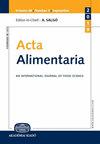白菜生长发育过程中理化特性和水分利用效率的变化。不同滴灌施肥和覆盖处理下的羊草(chinensis L.
IF 1
4区 农林科学
Q4 FOOD SCIENCE & TECHNOLOGY
引用次数: 0
摘要
在现代,园艺作物的营养特性是决定其对不同农业生态区域适应性的不可或缺的因素。本研究利用了覆盖物(P:塑料覆盖物;S:秸秆覆盖物;N:无覆盖物)与滴灌(I1:100%,I2:80%,I3:60%作物蒸散量(Etc))和灌溉施肥(F1:100%,F2:80%,F3:60%推荐施肥量(RDF))的关系:125 公斤 N、 62.5 公斤 P2O5,62.5 公斤 K2O/ha)在印度西北地区小白菜的三个成熟阶段。移植后55天植株鲜重最高(DAT);然而,最大土壤植物分析发展(SPAD)值记录在45DAT。在不同灌溉和施肥水平下,地膜覆盖植物的抗氧化活性、FRAP、DPPH、酚类、黄烷醇、总糖、抗坏血酸、游离氨基酸和灌溉用水效率显著较高。可以设想,在用银黑色覆盖、以80%Etc灌溉和以100%RDF施肥的地块中,小白菜植物在45DAT时具有最高的营养价值。在印度的半干旱和亚热带地区,富含营养的植物被用于制作绿色沙拉,并被用作许多食谱的配料。本文章由计算机程序翻译,如有差异,请以英文原文为准。
Variation in physio-chemical attributes and WUE during growth and development of Pak choi (Brassica rapa L. subsp. chinensis L.) under different drip fertigation and mulching treatments
In the modern era, nutraceutical properties of horticultural crops are indispensable to determine their adaptability to different agro-ecological regions. The present study exploits the potential of mulches (P: plastic mulch; S: straw mulch; N: No mulch) in relation to drip irrigation (I1: 100%, I2: 80%, I3: 60% of crop evapotranspiration (Etc)), and fertigation (F1: 100%, F2: 80%, F3: 60% of recommended dose of fertilizer (RDF): 125 kg N, 62.5 Kg P2O5, 62.5 kg K2O per ha) on Pak choi at three maturity stages in the North West region of India. Plant fresh weight was the highest at 55 days after transplanting (DAT); however, maximum soil plant analysis development (SPAD) values were registered at 45 DAT. Antioxidant activity, FRAP, DPPH, phenols, flavanols, total sugars, ascorbic acid, free amino acids, and irrigation water use efficiency were observed significantly higher in plants grown on plastic mulch at different levels of irrigation and fertigation. It is envisioned that Pak choi plants had the highest nutritional value at 45 DAT from plots mulched with silver-black, irrigated at 80% Etc, and fertigated at 100% RDF. The nutrient enriched plants are used for green salad and as ingredients for the preparation of many recipes in the semi-arid and sub-tropic areas of India.
求助全文
通过发布文献求助,成功后即可免费获取论文全文。
去求助
来源期刊

Acta Alimentaria
农林科学-食品科技
CiteScore
1.80
自引率
0.00%
发文量
47
审稿时长
18-36 weeks
期刊介绍:
Acta Alimentaria publishes original papers and reviews on food science (physics, physical chemistry, chemistry, analysis, biology, microbiology, enzymology, engineering, instrumentation, automation and economics of foods, food production and food technology, food quality, post-harvest treatments, food safety and nutrition).
 求助内容:
求助内容: 应助结果提醒方式:
应助结果提醒方式:


